Separation of Substances Class 6 Extra Questions Science Chapter 5
NCERT Extra Questions for Class 6 Science Chapter 5 Separation of Substances
Methods of separation
Question 1.
When is handpicking used?
Answer:
Handpicking is used to separate undesirable component when present in small
amount.
Question 2.
What is threshing? How is it done?
Answer:
The process that is used to separate the grain from stalks is threshing. In this process, the stalks are beaten to free the grain seeds. Sometimes, threshing is done with the help of bullocks. Machines are also used to thresh large quantities of grain.
Question 3.
Which type of separation is used in cashew nut factories?
Answer:
Sieving.
Question 4.
Give one example of sieving used in everyday life.
Answer:
Separation of barn (choker) from flour.
Question 5.
Name some materials that are used as filters.
Answer:
Cotton, ceramic, filter cloth, filter paper.
Question 6.
Name the process of separating two immiscible liquids.
Answer:
By using separating funnel or by decantation.
Question 7.
Which substance is used for loading?
Answer:
Alum (phitkari).
Question 8.
What is the use of alum in loading?
Answer:
Alum is used to make the sedimentation faster. Bv adding alum the clay particles settle down rapidly.
Question 9.
Which process is used to separate bacteria from water?
Answer:
Filtration, by using special filters, i.e., bacteria proof filter.
Question 10.
What is decantation?
Answer:
Decantation is a process of separating insoluble solids from liquids. A suspension of solid particles in liquid is allowed to stand for some time. Solid particles settle down at the bottom, due to their weight.
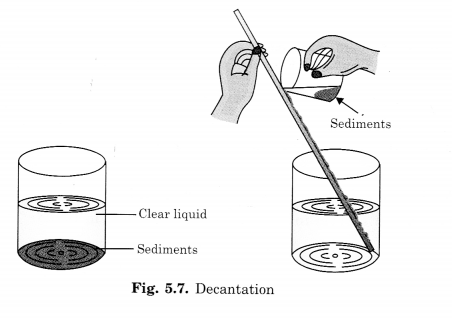
This is called sedimentation. The clean water is transferred into another beaker, without disturbing the settled particles. This type of separation is called decantation (Fig. 5.7).
Question 11.
What is the use of decantation?
Answer:
Decantation is used to separate insoluble solids from liquids. Two immiscible liquids are also separated by this process.
Question 12.
What is filtration?
Answer:
When one component of a mixture is soluble in water and other component is insoluble in water, the soluble component gets dissolved and insoluble one is separated by filtering the solution.
The process by which insoluble substance can be separated from a solution, by passing that solution through a porous paper (filter paper) is called filtration. During filtration, the solid insoluble substance is retained at the filter paper as residue while the liquid free from any suspended matter passes through the filter paper and is collected as filtrate. This filtrate may be warmed to dry to obtain soluble component. Figures 5.8 (a), (b), (c) show the folding and use of filter paper in filtration.

Question 13.
What is the drawback of evaporation?
Answer:
The liquid in the mixture is evaporated off into the air and is not recovered.
Question 14.
Name the process to obtain salt from seawater.
Answer:
Evaporation.
Question 15.
Which types of mixtures are separated by evaporation?
Answer:
Evaporation is used to separate solids dissolved in liquid.
Question 16.
Describe the method to obtain pure salt from rock salt.
Answer:
First, the mixture is crushed and grinded. Water is then added and filtered. Pure salt is collected as filtrate which is heated for evaporation. Water evaporates off and pure salt is left.
Question 17.
How will you separate pure water from a solution of salt in water?
Answer:
We can separate pure water from a solution of salt in water, by the process of distillation that is by evaporation and followed by condensation.
Question 18.
Write opposite process of condensation.
Answer:
Evaporation.
Question 19.
How is common salt obtained from seawater?
Answer:
When seawater is allowed to evaporate in shallow pits, water gets heated by sunlight and changes into water vapour by the process of evaporation leaving behind impure solid salts. Now, the lumps of impure common salt are crushed to get powdered salt. The powdered common salt is dissolved in water to prepare a solution. Now the solution of common salt is filtered to remove insoluble impurities. The clear solution is evaporated by heating to remove the water content to obtain a concentrated solution of common salt. The hot and concentrated solution is allowed to cool. On cooling, crystallization takes place and crystals of pure common salt are obtained.
Question 20.
What is the importance of centrifugation? How is it done?
Answer:
Centrifugation is the process of separating suspended particles from a liquid by rotating the liquid at a high speed.
The mixture is taken in a closed bottle and rotated at a high speed. The heavy particles settle at the bottom while light particles remain behind. This method is also used to separate cream from milk. Cream collects at the centre and being lighter than milk, it floats at the top of the mixture.
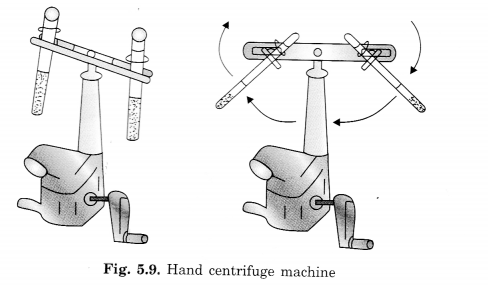
Question 21.
What do you mean by solubility?
Answer:
The maximum mass of a solute that can be dissolved in 100 g of the solvent at any specific temperature is called solubility.
Question 22.
Why is water a universal solvent?
Answer:
Water can dissolve different kinds of substances. That is why water is commonly called as a universal solvent.
Question 23.
What is the effect of temperature on solubility?
Answer:
Solubility increases when the increase in temperature takes place.
Question 24.
Differentiate between saturated and unsaturated solutions.
Answer:
Saturated solution: A solution in which no more solute can be dissolved at a given temperature.
Unsaturated solution: A solution in which more solute can be dissolved at any temperature.
Question 25.
During centrifugation, which particles settle down at the bottom?
Answer:
Heavy particles settle down at the bottom and lighter particles float at the top of the liquid.
Question 26.
Name the method by which you can separate butter from milk.
Answer:
Centrifugation.
Question 27.
Name the device by which cream can be separated from milk at home.
Answer:
A mixer-grinder is the very important device by which cream can be separated from milk. (Fig. 5.10)
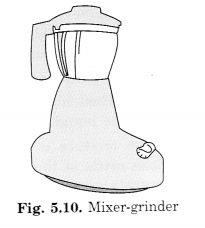
Question 28.
Why does visibility increase after rains?
Answer:
After rains, the objects at a distance are seen more clearly, because the fine dust particles that were present in air settle down due to loading by rain drops.
Question 29.
What is strainer?
Answer:
Wire mesh is commonly known as strainer. For example, while preparing tea, we separate tea leaves from water by using a filter such as wire mesh. Tea leaves are bigger in size than the holes of the mesh.
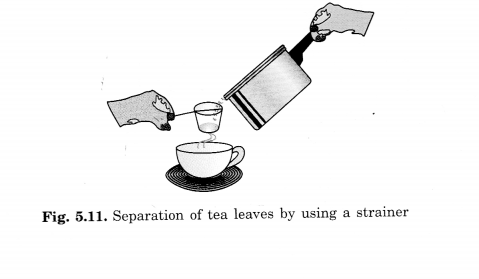
Question 30.
Name the property of the components used for separating the following mixtures:
- salt and camphor
- wheat and husk
- iron fillings and saw-dust
- coconut oil and water.
Answer:
- sublimation
- winnowing
- magnetic separation
- separating funnel.
Question 31.
Mention the methods that can be used for the separation of the following mixtures:
- wheat, sugar and husk
- rice, gram and iron fillings
- sand, Mack gram (urad) and husk.
Answer:
1. Mixture of wheat, sugar and husk.
- For separating husk from the mixture, we should follow the winnowing method as husk is lighter than other two components.
- Wheat and sugar can be separated by sieving as they have different sizes.
2. Mixture of rice, gram and iron fillings.
- For separating iron fillings, we can use a magnet.
- Rice and gram can be separated either by sieving or by handpicking.
3. Sand, black gram (urad) and husk.
- For separating sand from the mixture, we can sieve the mixture.
- Black gram (urad) and husk can be separated by the method of winnowing.
Question 32.
Write various methods of separation of compounds from their mixture.
Answer:
- Handpicking
- Threshing
- Winnowing
- Sedimentation
- Decantation
- Filtration
- Evaporation
- Condensation.
Question 33.
How will you Separate a mixture of common salt and chalk powder?
Answer:
We know that common salt is soluble in water while chalk is sparingly, soluble. So on the basis of different solubility, we can separate the common salt and chalk powder as follows:
1. First, some water is mixed with the mixture of common salt and chalk powder, stir the solution well. Filter the solution by using filter paper. On filtering, chalk powder is obtained as a residue on the filter paper and salt solution is obtained.
2. Now filtrate is evaporated and dry common salt is left behind.
Activity 2.
Bring a packet of food grain purchased from a shop to the classroom. Now, spread the grains on a sheet of paper. Do you find only one kind of grain on the sheet of paper? Are there pieces of stone, husks, broken grain and particles of any other grain in it?
No. There are pieces of stone, husks, broken grain, etc., in it.
Activity 3.
Make a mixture of dry sand with sawdust or powdered dry leaves. Keep this mixture on a plate or a newspaper. Look at this mixture carefully. Can the two
different components be made out easily? Are the sizes of particles of the two; components similar? Would it be possible to separate the components by handpicking?
Yes, we can separate two components from the mixture. Dry sand and sawdust have
different sizes of particles, we cannot separate out the components by handpicking.
Now, take your mixture to an open ground and stand on a raised platform. Put the mixture in a plate or sheet of paper. Hold the plate or the sheet of paper containing the mixture, at your shoulder height. Tilt it slightly, so that the mixture slides out slowly.
What happens? Do both the components – sand and sawdust (or powdered leaves) fall at the same place? Is there a component that blows away? Did the wind manage to separate the two components? :
No, sawdust will fall far from the sand as it is lighter. Sand dust blows away with the wind.
Activity 4.
Bring a sieve and a small quantity of flour from home, to the class. Sieve the flour to separate any impurities in it. Now, make a fine powder of chalk pieces and mix it with the flour. Can we separate the flour and the powdered chalk by sieving?
No, the flour and the powdered chalk cannot be separated by sieving because their particles are of the same size.
Activity 5.
Collect some muddy water from a pond or a river. If it is not available, mix some l soil to water in a glass. Let it stand for half an hour. Observe the water carefully ‘ and note your observations.
Does some soil settle at the bottom of water? Why? What will you call this j process?
Yes, some heavier soil particles settle at the bottom of the water. This process is called sedimentation.
Activity 6.
Heat a beaker containing some water. Allow the water to boil. If you continue heating, would the water turn into steam and disappear completely?
Yes, the water will disappear completely.
Now, add two spoons of salt to water in another beaker and stir it well. Do you
see any change in the colour of water? Can you see any salt in the beaker, after stirring?
Yes, the colour of water will become slightly white. No, salt cannot be seen in the beaker after stirring as it gets completely dissolved.
Heat the beaker containing the salt water (Fig.). Let the water boil away. What is left in the beaker?
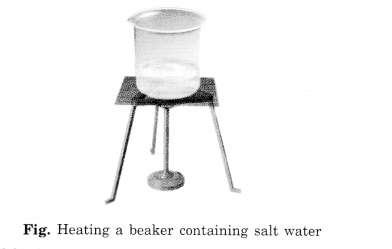
Some salt will be left in the beaker.
Activity 10.
Take two glasses and pour half a cup of water in each of them. Add a teaspoon of salt to one glass and stir till the salt dissolves. Go on adding salt, one teaspoon at a time, till the solution saturates. Record the number of spoons of salt that dissolved in the water, in Table 5.2. Now, repeat the same activity with sugar. Repeat this with some other substances that are soluble in water.
What do you notice from Table 5.2? Do you find that water dissolves different substances in different amounts?
Table 5.2
| Substance | Number of spoons of substance that dissolved in water |
| Salt | 1 spoon of salt in 100 gm water at 25°C |
| Sugar | 4 spoons of sugar in 100 gm water at 25°C |
| Copper sulphate | Nearly 4 spoon of copper sulphate in 100 gm of water at 25°C |
We notice from the table that different substances dissolve in water in different
amounts.
Objective Type Questions
Question 1.
Match the following items given in Column A with that in Column B:
| Column A | Column B |
| (a) Handpicking | (i) Conversion of water vapours into liquids |
| (b) Threshing | (ii) Separating bran from flour |
| (c) Winnowing | (iii) Separating larger size impurities |
| (d) Sieving | (iv) Separating butter from milk |
| (e) Sedimentation | (v) Conversion of water into Us vapours |
| (f) Evaporation | (vi) Separating grains from its stalks |
| (g) Condensation | (vii) Settling of heavier components at bottom |
| (h) Churning | (viii) Separation by wind or by blowing air |
Answer:
| Column A | Column B |
| (a) Handpicking | (iii) Separating larger size impurities |
| (b) Threshing | (iv) Separating grains from its stalks |
| (c) Winnowing | (viii) Separation by wind or by blowing air |
| (d) Sieving | (ii) Separating bran from flour |
| (e) Sedimentation | (vii) Settling of heavier components at bottom |
| (f) Evaporation | (v) Conversion of water into its vapours |
| (g) Condensation | (i) Conversion of water vapours into liquids |
| (h) Churning | (iv) Separating butter from milk |
Question 2.
Fill in the blanks with appropriate words:
- Peanuts are separated from a mixture of wheat and peanut by …………… .
- ………………. is used to separate husk from wheat.
- Fine sand can be separated from larger particles by ……………. .
- Glass is a ………….. .
- Compounds have ……………….. melting points.
- Milk has a ……………………….. boiling point.
- Boiling point of pure water is …………………. than that of impure water.
- Mixture may be solid, liquid or …………… .
- Butter is a component of …………….. .
- Sugarcane juice is a mixture of …………………………, water and many other substances.
- Separation of components is done to obtain a …………………….. substance.
- Components retain their properties in a ……………… .
Answer:
- handpicking
- Winnowing
- sieving
- mixture
- fixed
- variable
- less (x)
- gas
- butter milk
- sugar
- pure
- mixture
Question 3.
State whether the statements given below are True or False:
- Butter is separated from butter milk by churning.
- Separation of components of a mixture is a useful process.
- Ink loses its properties when mixed in water.
- ‘Sharbat’ is a mixture of sugar and water.
- Rocks are pure substances.
- Milk is a mixture.
- Common salt is ai pure substance.
- Mixture has properties different from its components.
- Tap water and pond water are alike.
- Elements are pure substances.
- A pure substance has a fixed melting and boiling points.
- Condensation method is used for separating substances which on heating change directly into vapour.
Answer:
- True
- True
- False
- True
- False
- True
- True
- False
- False
- True
- True
- False
Question 4.
Choose the correct option in the following questions:
(i)Butter is separated from milk by
(a) sedimentation
(b) filtration
(c) churning
(d) decantation
Answer:
(c) Butter is separated by churning.
(ii) Filtration is a method to separate the components of a
(a) solution
(b) mixture of a liquid and an insoluble substance
(c) both (a) and (b)
(d) pure substance
Answer:
(b) Components of solution cannot be separated by this method.
(iii) Threshing is done by
(a) beating
(b) bullocks
(c) machines
(d) all of these
Answer:
(d.) All the three methods can be used for threshing.
(iv) Which method is used to separate pebbles and stones from sand?
(a) Handpicking
(b) Winnowing
(c) Sieving
(d) Any of these
Answer:
(c) Handpicking will require more time while winnowing is not fit at all.
(v) The components of a solution (say sugar in water) can be separated by
(a) filtration
(b) evaporation
(c) sedimentation
(d) decantation
Answer:
(b) By evaporation, the volatile component is evaporated which is then condensed.
(vi) Sand from water is separated by
(a) sieving
(b) evaporation
(c) filtration
(d) sedimentation and decantation
Answer:
(d) It can be done by evaporation and filtration also but sedimentation and
decantation are easier ways.
(vii) The process of conversion of water vapours into liquid is called
(a) condensation
(b) decantation
(c) sedimentation
(d) evaporation
Answer:
(a) Water vapours changing into liquid is called condensation.
(viii) The process of conversion of water into its vapours is called
(a) evaporation
(b) condensation
(c) guttation
(d) transpiration
Answer:
(a) The conversion of water into vapours is called evaporation.
(ix) A mixture of ammonium chloride and sand is separated by
(a) evaporation
(b) decantation
(c) sublimation
(d) filtration
Answer:
(c) Ammonium chloride is separated by sublimation process.
(x) The property which forms the basis of sieving
(a) difference in weight
(b) difference in colour
(c) difference in shape
(d) difference in size
Answer:
(d) Sieving method is used for separating solid constituents of a mixture which differ in their size.
Extra Questions for Class 6 Science
<!–
–>